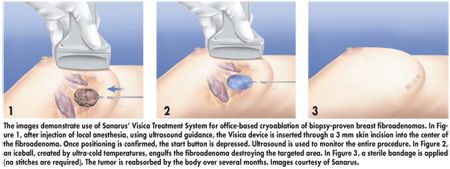Ablative therapy of primary breast ca in phase II trial
The treatment of primary breast cancers by cryoablation could offer a cosmetically appealing alternative to surgical lumpectomy if outcomes prove equivalent
NEW ORLEANSThe treatment of primary breast cancers by cryoablation could offer a cosmetically appealing alternative to surgical lumpectomy if outcomes prove equivalent, said Rache M. Simmons, MD, the Anne & Edwin Weiskopf Associate Professor of Surgical Oncology at Weill Medical College, Cornell University, New York.
Investigational methods include ablation by radiofrequency, laser, focused ultrasound, microwave, and cryoablation, Dr. Simmons said at the American College of Surgeons 93rd Annual Clinical Congress.
All ablative techniques are image-guided, which allows three-dimensional localization of tumor and pre-ablation size measurements. Core biopsy is preferred before ablation for definitive diagnosis and for obtaining tumor characteristics. This is comparable to how information is obtained prior to neoadjuvant chemotherapy, she pointed out.
"Skeptics feel they would be limited in not having tumor in their hands to examine," she said, "but I argue that this is no different than the case with neoadjuvant chemotherapy, where we base treatment decisions on pathologic complete response on the core biopsy."
With the cryoablative technique, argon gas creates a sonographic freezeball. Real-time ultrasound imaging shows the echogenic freezeball as it encompasses tumor, and allows the clinician to adjust the distance to the skin. Saline is injected between the freezeball and the skin, which creates a protective space for the skin. Freezing also acts as an anesthetic to the deep tissue, she said.
Cryoablation is already an FDA-approved treatment for fibroadenomas (see figure). In a multi-institutional series of 50 fibroadenoma patients, tumor volume decreased by 95% at 12 months, and there was resolution on imaging as well as physical examination (Kaufman et al: Am J Surg 184:394-400, 2002). In another study (Kaufman et al: J Am Coll Surg 198:914-923, 2004), the average treatment time for cryoablation of fibroadenomas was 24 minutes; 79% of procedures were performed in the office and 21% in the ambulatory operating room; and patient satisfaction was 94% at 12 months.
The advantages of this technique in fibroadenomas are fairly clear, and some of these translate to the breast cancer setting, Dr. Simmons said. The procedure is more comfortable than surgery; it leaves no residual palpable mass (unlike lumpectomy, since scar tissue does not develop); there is no ambiguity on post-treatment histology (ie, the successfully treated areas are clear); and the cosmetic result is better.

Of course, for breast cancer, studies must prove that the tumor is completely eradicated. This was shown in a study of 27 patients who underwent cryoablation for invasive breast cancer (mean tumor size 1.2 cm) followed by lumpectomy an average of 14 days later (Sable et al: Ann Surg Onc 11:542-549, 2004). Not only was the tumor 100% ablated, but investigators also observed what they believe to be an immunologic response to the cryoablation.
Phase II study underway
A phase II study is currently underway (ACOSOG Z1052) to evaluate, by mammography and MRI, the extent of residual disease after cryoablation therapy of invasive breast cancer, she said.
Dr. Simmons believes that if the outcomes prove acceptable, "cryoablation will offer patients an alternative to surgical resection in the future."
It is a minimally invasive procedure that can be performed in 20 minutes in the office under local anesthesia, she said, entails less discomfort during and after the procedure, and is more cost-effective. It has an obvious cosmetic advantage due to a smaller incision than lumpectomy, and it involves less long-term physical change to the breast, including less palpable scarring and less imaging distortion on future mammograms.
But William C. Wood, MD, professor of surgery, Emory University, commented that cryoablation is far from ready for prime time.
"We are sometimes surprised that there is more to a lesion than we see on the core biopsy," Dr. Wood noted. "If we excise the tumor, it is no longer in the body where it can do harm. If we leave it in place, we can only assume it has been ablated."